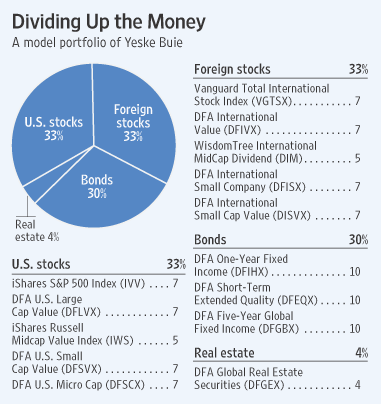WSJ: A Return to Real Estate

I’m writing to share a column that appeared in today’s Wall Street Journal that was devoted exclusively to Yeske Buie’s investment philosophy. Not every detail was exactly as we might have liked (for example, the columnist makes it sound like we time the real estate market, which we assuredly do not) but we believe Ms. Anand did a good job of capturing the key elements of our approach, which incudes a focus on global diversification, disciplined rebalancing, and cost control (https://online.wsj.com/article/SB10001424052970204488304574427321784293210.html).
A Return to Real Estate
With property prices having fallen around the world, this financial advisor sees opportunity in a global realty fund
By Shefali Anand
Individuals looking to dip their toes into real-estate securities should consider buying a mutual fund that invests both in the U.S. and abroad, says Dave Yeske, a financial planner in San Francisco. When buying risky assets like real estate, it’s best to spread your bets across companies and countries, he says.
 “We don’t believe investing solely in the U.S. gives us enough diversification,” says Mr. Yeske. Since late July, he has been buying a global real-estate fund for clients, to which he dedicates 4% to 6% of their portfolios.
“We don’t believe investing solely in the U.S. gives us enough diversification,” says Mr. Yeske. Since late July, he has been buying a global real-estate fund for clients, to which he dedicates 4% to 6% of their portfolios.
In this column, we ask prominent financial advisers who use mutual funds and exchange-traded funds to share model portfolios with us. Mr. Yeske, 52 years old, founded financial-planning firm Yeske & Co. in 1990 and last year merged it with Financial Planning Group of Vienna, Va., to form Yeske Buie. Mr. Yeske is a former chairman of the Financial Planning Association and is an instructor of financial planning at Golden Gate University in San Francisco. Yeske Buie manages about $300 million for some 200 clients, primarily individuals.
In late 2006, Mr. Yeske sold U.S. real-estate securities held by his clients, after they had nearly tripled in price. “It was seeming very expensive,” he says. Since the bust in the housing market that began in 2007, these securities have fallen dramatically. The MSCI U.S. REIT Index, an index of real-estate investment trusts, lost 38% in 2008, following a 17% decline in 2007. The market has come back this year, with the MSCI index up about 13% through Oct. 1.
REITs are entities that invest in different kinds of real estate or real-estate-related assets, including shopping centers, office buildings, hotels, and mortgages secured by real estate.
Despite this year’s rebound, many investors and advisers remain cautious on real estate, fearing that there could be further declines. In the U.S., for instance, it’s not clear yet that the housing market has bottomed, and the commercial real-estate market is still deteriorating.
“It might have further to fall, I don’t know,” says Mr. Yeske. But given the low prices after the market’s decline, he says he feels comfortable buying now.
Also, he notes that in the past few years a number of funds have popped up that invest in both U.S. and foreign real estate, giving him more global choices. Indeed, two-thirds of the 30-odd global real-estate mutual funds on the market now were launched after 2006, according to fund research firm Morningstar Inc.
To decide which investments to buy for clients and how to manage them, Mr. Yeske relies heavily on academic research. “We won’t do anything that’s not grounded in science,” he says.
One investing tenet that Mr. Yeske followed throughout the market downturn is rebalancing. Essentially, this involves adding money to investments that are losing value while selling those that are doing well. Since most asset classes were losing value last year, Mr. Yeske typically was adding to those investments that were losing more than others, mostly stocks.
That was in contrast to some other advisers, who held off buying stocks last year because they feared further declines.
Around two years ago, Mr. Yeske tweaked his approach, and started rebalancing only when an asset class moves 20% away from its target allocation, as opposed to the more commonly used range of 10%, to avoid too much short-term trading. “Look frequently but trade infrequently,” says Mr. Yeske, who usually looks at the value of client portfolios every two weeks.
Since last year, Mr. Yeske has rebalanced client portfolios four times, including the most recent round in August. Last fall and earlier this year, he was buying small stocks and “value” stocks, which are considered cheap based on prices and earnings. He notes that since the market bottom on March 9, large-cap value and small-company stocks have risen more than some of the other stock classes, such as fast-growing or “growth” companies. From March 9 through Oct. 1, for instance, the Russell 1000 Value Index rose 59%, versus 49% for the Russell 1000 Growth Index.
Here Mr. Yeske shares a model portfolio for clients in retirement, who make up a third of his firm’s clientele.
U.S. STOCKS: The portfolio’s 33% U.S.-stock allocation is invested mostly in value stocks and small stocks. That’s based on studies by economists Eugene Fama and Kenneth French that concluded that over long periods, value stocks tend to have better returns than growth companies. These studies also show that small stocks, which are riskier than large-company stocks, tend to outperform the latter over the long run.
To make these and other investments, Mr. Yeske and his team rely primarily on funds offered by Dimensional Fund Advisors Inc. DFA uses computer models to identify securities to buy within certain parameters, such as small value stocks. Its investing philosophy is based on Fama-French research, so a number of DFA funds are biased toward value and small stocks. The funds’ turnover and trading costs are typically quite low, like those of index-tracking funds.
“DFA [funds] represent the best blend of both passive and active,” says Mr. Yeske.
When creating client portfolios, Mr. Yeske typically starts by using a fund that provides broad stock-market exposure and then adds funds that focus on value stocks. So for allocation to large stocks, he invests 7% of assets each in the iShares S&P 500 Index ETF, tracking the Standard & Poor’s 500-stock index, and DFA U.S. Large Cap Value.
For an allocation of 5% to medium-size companies, Mr. Yeske uses the iShares Russell Midcap Value Index ETF. Finally, 7% each is invested in DFA U.S. Small Cap Value and DFA U.S. Micro Cap. “Small caps exhibit higher returns in the long term; in the short term, they provide diversification benefit,” says Mr. Yeske.
 FOREIGN STOCKS: In recent months, Yeske Buie advisers have increased the portfolio’s allocation to foreign stocks, to make it equal to the U.S.-stock allocation of 33%.
FOREIGN STOCKS: In recent months, Yeske Buie advisers have increased the portfolio’s allocation to foreign stocks, to make it equal to the U.S.-stock allocation of 33%.
The advisers say there’s no evidence to show that there’s any benefit in investing more money in one region of the world than another. “Those kind of judgment calls are wrong as much as they’re right,” says Mr. Yeske. By keeping their geographic allocation neutral, he says, they are able to draw from a broader universe of value and small-company stocks.
Like the U.S. allocation, the foreign portion is tilted toward value and small stocks. There is a 7% allocation to the Vanguard Total International Stock Index fund, which invests in stocks around the world and provides the portfolio’s only exposure to emerging markets like China and India. Another 7% is dedicated to DFA International Value, which buys large-company value stocks of developed countries.
There is a 5% allocation to WisdomTree International MidCap Dividend, and 7% each goes to DFA International Small Company and DFA International Small Cap Value.
BONDS: Last year, Mr. Yeske tapped only the portfolio’s bond allocation, made up of high-quality bonds, to make withdrawals for retired clients. This kept them from being forced to sell stocks to meet their income needs. Mr. Yeske says he views the fixed-income allocation as “our stable reserve.”
The 30% bond allocation is dedicated to mutual funds that invest in short- to medium-term bonds. The longer a bond’s maturity, the more it fluctuates in price for a given change in interest rates. And the yields on those longer-dated bonds may not be much higher than those on the short- or medium-term ones. “When you get beyond five years, you get a lot of volatility and very little additional returns,” sums up Mr. Yeske.
He splits the allocation equally among three DFA funds, which invest in high-quality bonds of various types, including mortgage-related bonds and corporate bonds. DFA One-Year Fixed Income aims to provide stable returns in excess of inflation. DFA Short-Term Extended Quality dips a little lower in the quality spectrum of bonds, but its average bond quality is still investment-grade. Finally, DFA Five-Year Global Fixed Income invests both in the U.S. and abroad, and can also hedge against currency fluctuations.
Until some months ago, Mr. Yeske owned two Pimco funds for his bond allocation, with expenses of 0.45% or more. In comparison, DFA’s bond funds charge 0.28% or less, so the advisers decided to shift to the lower-cost alternative. Costs are “one of the few things that you can control,” says Mr. Yeske, who firmly believes they should be kept to a minimum.
REAL-ESTATE SHARES: Like many advisers, Mr. Yeske believes that real-estate investments can help diversify a portfolio because they perform differently than other investments.
While in 2008 this was not so much the case, because most asset classes were losing value at the same time, Mr. Yeske notes that during the bear market for stocks in 2000 and 2001, real estate was one of the few investments that held up.
Also, he says that assets are rarely totally uncorrelated. “The only choice that’s available to you is assets that are relatively uncorrelated,” says Mr. Yeske. Even last year, he notes, some asset classes were losing more value than others.
His 4% allocation to real estate is through DFA Global Real Estate Securities, a fund of funds that invests in a U.S. and an international real-estate fund offered by DFA. The underlying funds own REITs and companies considered to be REIT-like entities in various countries, including emerging markets.
—Ms. Anand is a personal-finance columnist for The Wall Street Journal, based in New Delhi, India.
https://online.wsj.com/article/SB10001424052970204488304574427321784293210.html
